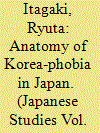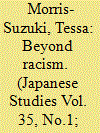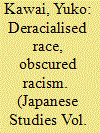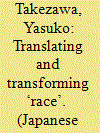|
|
|
Sort Order |
|
|
|
Items / Page
|
|
|
|
|
|
|
| Srl | Item |
| 1 |
ID:
140345


|
|
|
|
|
| Summary/Abstract |
This article explores the history and theoretical implications of Korea-phobia in Japan, focusing on hate incidents such as a demonstration by the Zaitokukai group which hoisted flags and blasted hate speech through a loudspeaker at an elementary school for Korean children in Kyoto in 2009. An analysis of such speech reveals that these actions are not so new, and instead rely on what we might call the historical layers of Korea-phobia in Japan. Korea-phobia in contemporary Japan must be understood from a historical perspective that traces anti-Korean racism back to the opening decade of the twentieth century when Japan seized Korea as a colony.
|
|
|
|
|
|
|
|
|
|
|
|
|
|
|
|
| 2 |
ID:
140346


|
|
|
|
|
| Summary/Abstract |
The special issue ‘Rethinking Race and Racism from Japanese Experiences’ explores how racism operates in modern Japan. This article contributes to that exploration by examining how racism is situated within a nexus of interrelated forms of discrimination and marginalization. In the article I propose the notion of ‘semi-citizenship’ as one framework which can help us to go beyond unfruitful zero-sum-game visions of marginalization put forward by racist groups such as the Zaitokukai in Japan. Rather than envisioning a dichotomous contrast between ‘citizen’ and ‘non-citizen’, the idea of semi-citizenship allows us to think of a range of different sets of social positions stretching towards the idealized vision of the ‘full citizen’. We can then start to consider how such social positions are distributed within modern societies, how they are influenced by factors such as ethnicity, gender and physical and mental attributes, and how the distribution changes over time. This approach offers a common ground on which various kinds of marginalization may be related and understood together, potentially providing a basis for collaborative work to create a more equitable Japanese society.
|
|
|
|
|
|
|
|
|
|
|
|
|
|
|
|
| 3 |
ID:
140344


|
|
|
|
|
| Summary/Abstract |
This paper examines the interrelationships among Japaneseness, the Western and Japanese concepts of race, and the obfuscation of racism in contemporary Japanese society. The concept of race, which was conceived in the West in the modern era, has influenced the Japanese concepts of race, jinshu and minzoku. These two concepts played a key role in constructing modern Japan’s identity by distinguishing it from its significant discursive Others: Asia and the West. Today the Japanese simply call themselves nihonjin, or Japanese people, rarely using the terms jinshu and minzoku, and racism is generally viewed as a ‘foreign issue’ that has little relevance to Japanese society. The purpose of this study is threefold. First, it discusses how the Japanese concepts of race, jinshu and minzoku, were constructed and shaped the dominant meaning of the Japanese in different historical contexts, intertwining with Western notions of race, nation, Volk, and ethnicity. Second, it suggests that obscured racism in contemporary Japan is linked with the conceptual presence and nominal absence of jinshu and minzoku in defining Japaneseness. Third, it explores how the contemporary modality of racism in Japan overlaps with and differs from racisms in the West.
|
|
|
|
|
|
|
|
|
|
|
|
|
|
|
|
| 4 |
ID:
140347


|
|
|
|
|
| Summary/Abstract |
The literature on education in Japan typically focuses attention on achievements in the classroom. In this study, I cross the border of scholarly attention to bukatsu (extracurricular school clubs), including their demanding schedules and mandatory activities, to analyze their rich roles in preparing students for future jobs. Refocusing attention from the classroom to the playground blurs hierarchies of activity and suggests a more holistic view of education. Drawing from extensive fieldwork in Japan that includes interviews and participant observation, I locate the value of bukatsu as generating a specific type of embodied cultural capital that is explicitly requested during the hiring process in the adult work world. The bukatsu experience reinforces certain attitudes that correspond with the bu (‘warrior’) part of the old bunburyōdō (‘the way of both pen and sword’) ideal. This research demonstrates the limits of academic credentials (i.e., test scores) in achieving larger societal goals. What seems to matter increasingly in a shrinking job market are dispositions derived from long-term participation in sports organizations, gained specifically through the institution of bukatsu.
|
|
|
|
|
|
|
|
|
|
|
|
|
|
|
|
| 5 |
ID:
140348


|
|
|
|
|
| Summary/Abstract |
The picture scroll Haseo sōshi (The Tale of Lord Haseo, dated between the end of the thirteenth century and the early fourteenth century) tells of Ki no Haseo (845–912), a famous scholar-poet, who gambles with an oni (demon or ogre) for a female prize who turns out to be a concoction from parts of dead bodies. With a variety of vivid characters, the Tale of Lord Haseo is a captivating story from the otogizōshi (literally ‘companion tales’) genre. Importantly, the text reveals medieval Japanese thought about the relationship between humans and demons, the creation of life from death, and beliefs in supernatural beings.
|
|
|
|
|
|
|
|
|
|
|
|
|
|
|
|
| 6 |
ID:
140343


|
|
|
|
|
| Summary/Abstract |
Although it is an almost established understanding in European and North American literature that race is a social construct, the general academic and social discourses surrounding race in Japan remain outside this model. This can be traced back to school textbooks and geography books in the early Meiji period, after these concepts and words were translated and introduced from Europe and the United States. This article will examine passages related to race in textbooks from the first half of the Meiji period, in order to explore the continuities and discontinuities in the state of knowledge production surrounding race and racial discrimination in contemporary Japan. Investigating the usage of words in educational practice allows us to see how ‘race’ was a term that was located in a position different from that of other words, and how the Japanese transformed their racial position in relation to others.
|
|
|
|
|
|
|
|
|
|
|
|
|
|
|
|
|
|
|
|
|